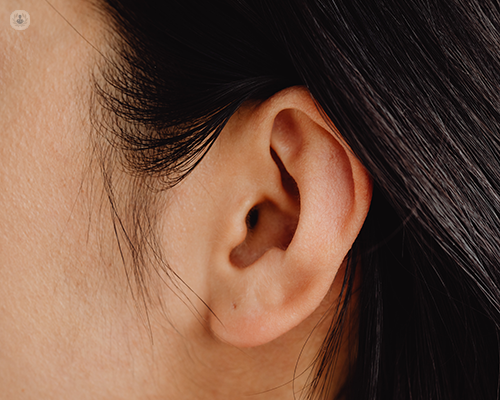Outer and middle ear infections: An expert insight
Escrito por:Ear infections are a very common illness, particularly in children, that can cause earache and discomfort.
Here, Professor Mahmood Bhutta, renowned consultant ENT surgeon, provides an expert insight into outer and middle ear infections, including causes and treatment.

What is an ear infection, and what are the symptoms?
Ear infections are of different kinds:
- Outer ear infections - in the ear canal (the tube that goes towards the eardrum).
- Middle ear infections - deep into the eardrum, where the bones of hearing reside.
The symptoms of an ear infection are usually a discharge coming out of the ear that sometimes is a watery discharge and that sometimes is a thick discharge with pus. There can be some pain and discomfort, as well as some hearing loss.
What are the different types of ear discharge?
There are different kinds of ear discharge:
- Watery discharge associated with itchiness - typically, this indicates an outer ear infection.
- Thick discharge with pus coming out of the ear - typically, this indicates a middle ear infection.
If there is a lot of pain and a temperature before the pus comes out of the ear, this can indicate an acute ear infection. An acute ear infection is an infection that has happened recently, following a cold.
If pus comes out of the ear from time to time with very little pain, this can indicate a hole in the eardrum or a cholesteatoma, a rare condition where the skin of the eardrum has started to grow inwards and has caused a hole.
What can cause an ear infection, and what can cause ear discharge?
The causes of ear discharge can be varied. Sometimes, it can also be very difficult to find out what exactly is causing the ear discharge.
If it is an outer ear infection, it may be caused by water that has gotten inside the ear. Classically, this happens after swimming. In addition, it may also be caused by an underlying problem with the skin of the ear canal, such as an eczema, that can make someone more prone to outer ear infections.
If it is a middle ear infection, it may be caused by a cold that lead to intense pain with discharge and the busting of the eardrum, which causes pus to come out. Frequently, this affects children because their immune systems are a little weaker, but it can also affect adults who are more prone to middle ear infections.
If it is a hole in the eardrum, it may be caused by a bad ear infection that lead to the bursting of the eardrum. It may also be caused by trauma to the eardrum. Rarely, it may be caused by a cholesteatoma, which is more than simple belly button fluff getting stuck with a bit of skin. A cholesteatoma is an active growth of a skin from the eardrum that keeps growing and growing, and eventually goes on to damage various other structures in the ear and even in the brain.
Above all, if someone has an ear that continues to discharge, it is important to go and see an expert.
How are ear infections treated? Is ear discharge treated any differently?
Outer ear infections are treated differently from middle ear infections.
The main treatment for outer ear infections are antibiotic drops, which are placed directly into the ear in high concentrations to kill any bacteria that may be there. Usually, the infection settles down with the use of antibiotic drops.
If the infection is still present, however, an ear cleaning will be required to remove any pus and debris inside the ear, allowing the antibiotic drops to work more effectively.
Occasionally, some ear infections just won’t settle down and will keep coming back, and this is exactly why medical attention needs to be sought. If someone has an undiagnosed hole in the eardrum, for example, this can make someone more prone to getting recurrent ear infections that may require a repair of the eardrum to treat the problem and possibly, improve hearing as well.
A cholesteatoma always requires surgery to open up the ear and remove all the skin away, because a cholesteatoma won’t disappear on its own and could cause more serious problems going forward.
How do infections and discharge that affect the middle ear differ from those of the outer ear?
If someone has an inkling about itching in the ear and this ends up being discharge and discomfort, this might indicate an outer ear infection. If there is actual pus coming out of the ear, this tends to indicate a middle ear infection. However, generally, it is very difficult to necessarily differentiate an outer ear infection from a middle ear infection.
If an ear infection keeps causing problems, then medical attention should really be sought.
If you require expert assessment and treatment for an ear infection, don’t hesitate to book an appointment with Professor Mahmood Bhutta via his Top Doctors profile today.


